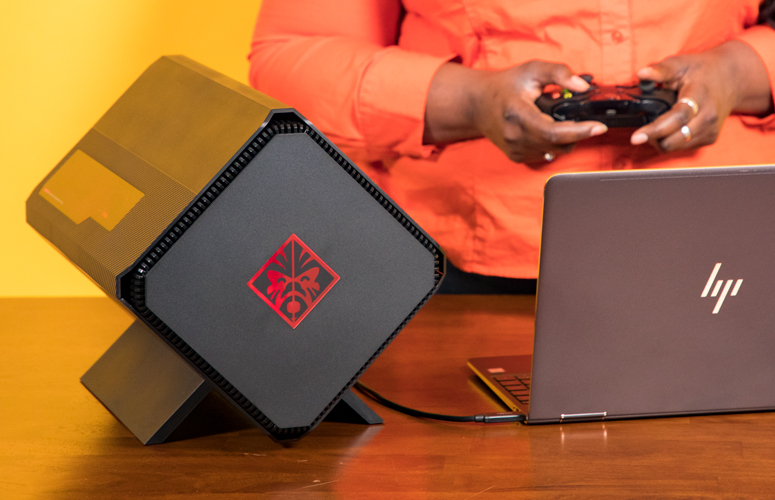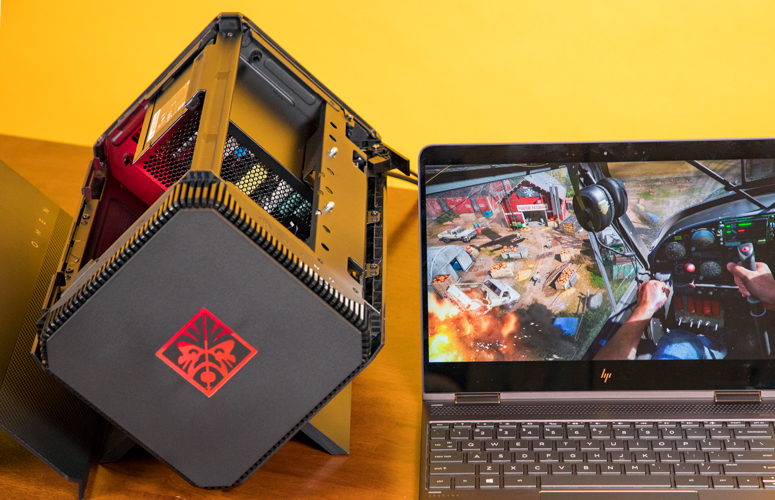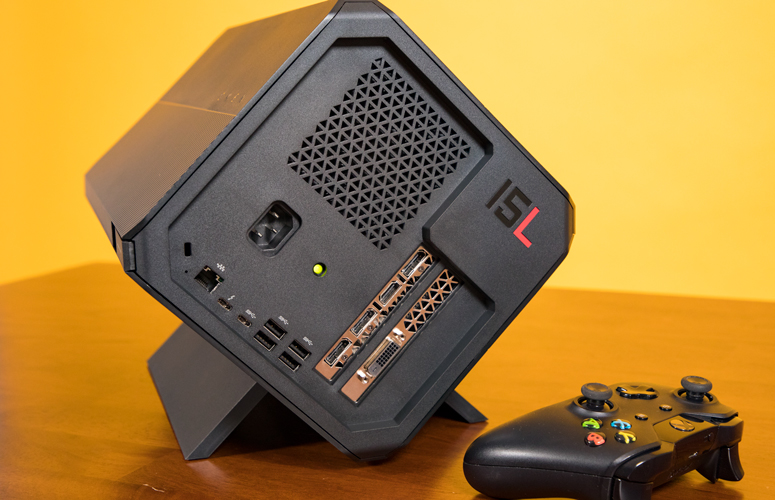Laptop Mag Verdict
The HP Omen Accelerator turns your ultraportable into a serious gaming laptop for an affordable price.
Pros
- +
Simple plug-and-play setup
- +
Supports gaming GPUs of various sizes
- +
Can install HDD or SSD
- +
Whisper-quiet fans
- +
Affordable
Cons
- -
Lacks workstation GPU support
Why you can trust Laptop Mag
An ultraportable laptop can do a lot of things: stream video, crunch numbers, edit photos, and, to a certain extent, handle a little gaming. But while "a little" is all some people want or need, we gamers need something slightly more robust.
That's when it's time for the HP Omen Accelerator, a $299 external GPU that can transform your mild-mannered ultraportable into a legitimate gaming laptop, provided it has a Thunderbolt 3 port. Even better, you can install either an SSD or a hard drive so you can keep business and pleasure neatly separated.
Design
HP has taken "go big or go home" to heart with the Omen Accelerator. At 12 pounds and 15.8 x 7.9 x 7.9 inches, this is one eGPU that's not trying to be subtle. For one thing, it looks like a sideways cube. The entire setup rests on a pair of feet sticking out the bottom to ensure the structure doesn't tip over. It's the polar opposite of the sleek Razer Core V2, with its slim 10.1 pounds, 11.8 x 5.7 x 1.7-inch black aluminum chassis.
Mirroring the design of the redesigned Omen laptops, the Accelerator is made primarily from smooth black matte plastic with several panels with a faux carbon-fiber pattern and a glass panel on the top left.
Toward the back of the right panel Omen is spelled out in large silver lettering. The Omen emblem on the front of the device gleams silver until it's powered on. Then it glows in a seductive, yet menacing blood red.
The bottom panels are where all your cooling vents reside.
Sign up to receive The Snapshot, a free special dispatch from Laptop Mag, in your inbox.
You'll find another vent in the back of the Accelerator along with four USB 3.0 ports, a USB Type-C, a Thunderbolt 3, a Gigabit Ethernet, a secure lock slot and a power port. There's a shiny 15L logo in the top-left corner.
Compatibility
Although the Omen Accelerator ships with either an Nvidia GeForce GTX 1060 or 1070 GPU, the eGPU is compatible with over 20 cards from both AMD and Nvidia, including the GTX Titan X, AMD Radeon RX 580, GTX 1080 Ti and Radeon RX 570.
MORE: The Best Headsets for Immersive Gaming
That's great if you want to game or edit videos, but if you're looking to run CAD software or something that needs to run the advanced double precision computations needed in scientific calculations, you'll have to look elsewhere. The Omen Accelerator doesn't support Nvidia Quadro or AMD FirePro cards -- but the Core V2 does. However, both eGPUs support laptops with either dual-lane or quad-lane Thunderbolt 3 ports.
Setup
The Accelerator reminds me of a convertible, because you have to take the top off before you start having any real fun. You remove the top portion via the Internal Access latch on its right. From there, installing your GPU is as simple as removing two screws with a Phillips-head screwdriver -- one screw holds the plate that will eventually cradle your graphics card and the other, bright red one holds the GPU in place one it's inserted. What I like about the PCIe slot is that it has two potential screw holes to accommodate cards both large and small.
The interior also has housing for either a hard drive or an SSD. And just like a regular desktop, the component is secured via a series of screws. It's a really handy feature to have, since that means you don't have to take up precious space on your ultraportable with large game installs. But I didn't have to worry about futzing around in the Accelerator's innards because my review unit shipped with a 1TB 7,200-rpm hard drive and a GTX 1070 GPU.
I could barely hear the Accelerator when it was connected to our test laptops, which was a welcome relief from the Core V2, which is distractingly loud.
Once I was ready to start gaming, I simply connected the Accelerator to my HP Spectre 13 via Thunderbolt cable, and the front logo and the glass panel began to glow red. Meanwhile, an Omen Accelerator app launched on the notebook that highlighted that the eGPU was up and running. The Accelerator app lets you toggle auto-launch and auto-switch settings, manually switch between GPUs and set network bandwidth priorities for different apps and programs.
MORE: The Best Gaming Laptops
Aside from the added benefit of having integrated storage along with your GPU, my favorite thing about the Omen Accelerator is how quiet it is. I could barely hear it when it was connected to our test laptops, which was a welcome relief to the Core V2, which is distractingly loud.
Gaming Performance
With the Omen Accelerator and a desktop Nvidia GeForce GTX 1070 GPU, we turned the HP Spectre 13 into a gaming force to be reckoned with, able to keep up with a true gaming system. We also used the Omen Accelerator with the Razer Blade Stealth and the Dell XPS 13 and ran our regular gaming benchmarks, bypassing each ultraportables' integrated Intel GPU.
The Omen Accelerator turned the HP Spectre 13 into a gaming force to be reckoned with.
MORE: PS4 Games: Our Staff Favorites
On the Hitman benchmark, the Spectre and the XPS 13 scored 56 and 55 fps while the Stealth delivered an impressive 66 fps connected to the Omen Accelerator. With the Core V2, the Spectre, the XPS 13 and the Stealth scored 53, 65 and 67 fps, respectively.
That performance boost carries over to the VR side of the equation. When we ran the SteamVR Performance test with the Omen Accelerator, the XPS 13, Spectre and Stealth obtained 9.3, 9.4 and 9.5 each, which places them in the Very High quadrant of the test. The Core V2 did equally well with the Stealth, Spectre and XPS 13 achieving scores of 9.6, 9.4 and 9.3, respectively.
Bottom Line
HP is serving up big heaping serving of performance and value with the Accelerator, and I'm ready for seconds. For $299, you get an eGPU with rather striking looks that can support a number of different graphics cards and laptops with dual-or-quad-lane Thunderbolt 3 ports. Even better, you can install either a hard drive or a SSD to hold all your games, freeing up your laptop's storage for other uses.
However, if you're looking for an eGPU with a sleeker, more premium build and with customizable backlighting that can support powerful workstation GPUs, you should consider the Razer Core V2. However, you're going to pay a pretty penny for the privilege, to the tune of $499. Overall, the HP Omen Accelerator is an excellent choice for consumers looking to transform their ultraportable from a slim business and multimedia machine to bona fide gaming beast.
Credit: Shaun Lucas/Laptop Mag
- Our Favorite Gaming Keyboards
- Our Favorite Gaming Mice for Every Genre
- The Best Headsets for Immersive Gaming
HP Omen Accelerator Specs

Sherri L. Smith has been cranking out product reviews for Laptopmag.com since 2011. In that time, she's reviewed more than her share of laptops, tablets, smartphones and everything in between. The resident gamer and audio junkie, Sherri was previously a managing editor for Black Web 2.0 and contributed to BET.Com and Popgadget.





